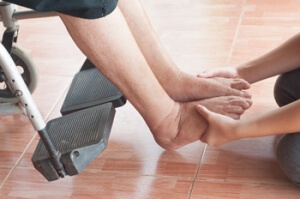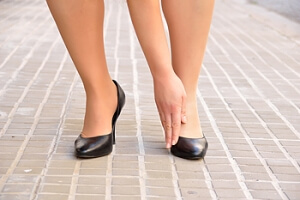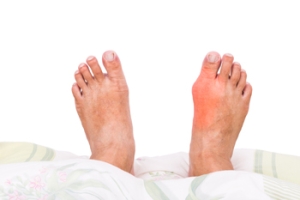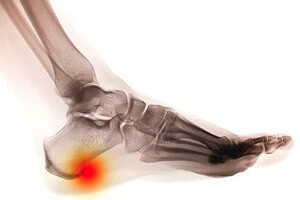
Plantar Warts
Plantar warts are growths that typically appear on the heels or other weight-bearing areas of the feet. These warts are caused by the human papillomavirus (HPV). The virus enters the body through breaks in the skin, such as cuts, that are on the bottom of the feet. Plantar warts are more likely to affect children and teenagers, people with weakened immune systems, people who have a history with plantar warts, and people who walk barefoot in environments exposed to a wart-causing virus.
If you suspect you have plantar warts, you may have the following symptoms: pain or tenderness while walking, a lesion that interrupts the ridges in the skin of your foot, small fleshy lesions on the bottom of the foot, or a callus where a wart has grown inward over a well-defined spot on the skin.
HPV causes plantar warts to form and is very common. There are more than 100 kinds of the virus in existence. However, only a few of them cause warts on the feet. The other types of HPV are likely to cause warts on other parts of the body.
If you have plantar warts, your podiatrist may try different treatment methods depending on your specific case. Some treatments for plantar warts are peeling medicines (salicylic acid), freezing medicines (cryotherapy), or surgical procedures. Laser treatments and vaccines are also used to treat plantar warts.
Three Areas of Peripheral Neuropathy
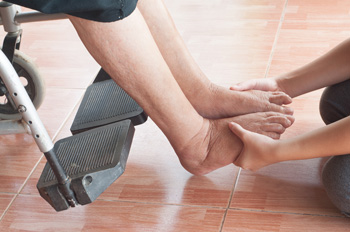 Patients who are afflicted with peripheral neuropathy are typically familiar with a tingling sensation or numbness in their feet that generally accompanies this uncomfortable condition. Additional symptoms may include difficulty in walking, feeling a stabbing pain that may be in the feet, or experiencing muscle weakness. Research has shown the peripheral nerves are categorized into three areas. One group is known as the motor nerves and will affect performing activities that may include walking or picking up an object. Additionally, sensory nerves affect the ability to differentiate between hot and cold, or objects that are smooth or rough. Finally, autonomic nerves control specific functions of the body, which may include digestion, heart rate, and blood pressure. If you are experiencing symptoms in the feet that may indicate neuropathy, it is suggested to consult with a podiatrist, so a proper diagnosis can be performed.
Patients who are afflicted with peripheral neuropathy are typically familiar with a tingling sensation or numbness in their feet that generally accompanies this uncomfortable condition. Additional symptoms may include difficulty in walking, feeling a stabbing pain that may be in the feet, or experiencing muscle weakness. Research has shown the peripheral nerves are categorized into three areas. One group is known as the motor nerves and will affect performing activities that may include walking or picking up an object. Additionally, sensory nerves affect the ability to differentiate between hot and cold, or objects that are smooth or rough. Finally, autonomic nerves control specific functions of the body, which may include digestion, heart rate, and blood pressure. If you are experiencing symptoms in the feet that may indicate neuropathy, it is suggested to consult with a podiatrist, so a proper diagnosis can be performed.
Neuropathy
Neuropathy can be a potentially serious condition, especially if it is left undiagnosed. If you have any concerns that you may be experiencing nerve loss in your feet, consult with one of our podiatrists from Apple Podiatry Group. Our doctors will assess your condition and provide you with quality foot and ankle treatment for neuropathy.
What Is Neuropathy?
Neuropathy is a condition that leads to damage to the nerves in the body. Peripheral neuropathy, or neuropathy that affects your peripheral nervous system, usually occurs in the feet. Neuropathy can be triggered by a number of different causes. Such causes include diabetes, infections, cancers, disorders, and toxic substances.
Symptoms of Neuropathy Include:
- Numbness
- Sensation loss
- Prickling and tingling sensations
- Throbbing, freezing, burning pains
- Muscle weakness
Those with diabetes are at serious risk due to being unable to feel an ulcer on their feet. Diabetics usually also suffer from poor blood circulation. This can lead to the wound not healing, infections occurring, and the limb may have to be amputated.
Treatment
To treat neuropathy in the foot, podiatrists will first diagnose the cause of the neuropathy. Figuring out the underlying cause of the neuropathy will allow the podiatrist to prescribe the best treatment, whether it be caused by diabetes, toxic substance exposure, infection, etc. If the nerve has not died, then it’s possible that sensation may be able to return to the foot.
Pain medication may be issued for pain. Electrical nerve stimulation can be used to stimulate nerves. If the neuropathy is caused from pressure on the nerves, then surgery may be necessary.
If you have any questions, please feel free to contact our offices located in Arlington Fort Worth, And Flower Mound, TX . We offer the newest diagnostic and treatment technologies for all your foot care needs.
Neuropathy
Neuropathy is a condition in which the nerves in the body become damaged from a number of different illnesses. Nerves from any part of the body, including the foot, can be damaged. There are several forms of neuropathy including peripheral neuropathy, cranial neuropathy, focal neuropathy, and autonomic neuropathy. Furthermore there is also mononeuropathy and polyneuropathy. Mononeuropathies affect one nerve while polyneuropathies affect several nerves. Causes of neuropathy include physical injury, diseases, cancers, infections, diabetes, toxic substances, and disorders. It is peripheral neuropathy that affects the feet.
The symptoms of neuropathy vary greatly and can be minor such as numbness, sensation loss, prickling, and tingling sensations. More painful symptoms include throbbing, burning, freezing, and sharp pains. The most severe symptoms can be muscle weakness/paralysis, problems with coordination, and falling.
Podiatrists rely upon a full medical history and a neurological examination to diagnose peripheral neuropathy in the foot. More tests that may be used include nerve function tests to test nerve damage, blood tests to detect diabetes or vitamin deficiencies. Imaging tests, such as CT or MRI scans, might be used to look for abnormalities, and finally nerve or skin biopsies could also be taken.
Treatment depends upon the causes of neuropathy. If the neuropathy was caused by vitamin deficiency, diabetes, infection, or toxic substances, addressing those conditions can lead to the nerve healing and sensation returning to the area. However if the nerve has died, then sensation may never come back to the area. Pain medication may be prescribed for less serious symptoms. Topical creams may also be tried to bring back sensation. Electrical nerve stimulation may be used for a period of time to stimulate nerves. Physical therapy can strengthen muscle and improve movement. Finally surgery might be necessary if pressure on the nerve is causing the neuropathy.
If you are experiencing sensation loss, numbness, tingling, or burning sensations in your feet, you may be experiencing neuropathy. Be sure to talk to a podiatrist to be diagnosed right away.
High Heels and the Achilles Tendon
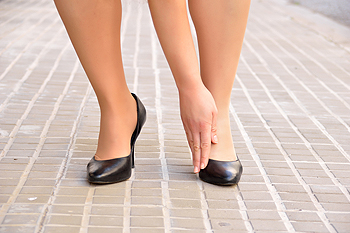 Many women enjoy wearing high heels despite having the knowledge that the feet may be negatively affected. Research has shown the Achilles tendon may become shorter and stiffness may occur as a possible result of frequently wearing high heels. Additionally, balance and posture may become affected as the center of gravity changes, and the muscles surrounding the ankle may be compromised. There may be solutions that can be implemented to protect the feet from wearing high heels, and these may include choosing to wear shoes that have a lower heel, reducing the amount of days and time spent wearing high heels, or wearing soft insoles, which may provide adequate cushioning for the feet. If you would like additional information about the effects high heels can have on your feet, please speak with a podiatrist who will be able to suggest proper foot strengthening exercises.
Many women enjoy wearing high heels despite having the knowledge that the feet may be negatively affected. Research has shown the Achilles tendon may become shorter and stiffness may occur as a possible result of frequently wearing high heels. Additionally, balance and posture may become affected as the center of gravity changes, and the muscles surrounding the ankle may be compromised. There may be solutions that can be implemented to protect the feet from wearing high heels, and these may include choosing to wear shoes that have a lower heel, reducing the amount of days and time spent wearing high heels, or wearing soft insoles, which may provide adequate cushioning for the feet. If you would like additional information about the effects high heels can have on your feet, please speak with a podiatrist who will be able to suggest proper foot strengthening exercises.
High heels have a history of causing foot and ankle problems. If you have any concerns about your feet or ankles, contact one of our podiatrists from Apple Podiatry Group. Our doctors can provide the care you need to keep you pain-free and on your feet.
Effects of High Heels on the Feet
High heels are popular shoes among women because of their many styles and societal appeal. Despite this, high heels can still cause many health problems if worn too frequently.
Which Parts of My Body Will Be Affected by High Heels?
- Ankle Joints
- Achilles Tendon – May shorten and stiffen with prolonged wear
- Balls of the Feet
- Knees – Heels cause the knees to bend constantly, creating stress on them
- Back – They decrease the spine’s ability to absorb shock, which may lead to back pain. The vertebrae of the lower back may compress.
What Kinds of Foot Problems Can Develop from Wearing High Heels?
- Corns
- Calluses
- Hammertoe
- Bunions
- Morton’s Neuroma
- Plantar Fasciitis
How Can I Still Wear High Heels and Maintain Foot Health?
If you want to wear high heeled shoes, make sure that you are not wearing them every day, as this will help prevent long term physical problems. Try wearing thicker heels as opposed to stilettos to distribute weight more evenly across the feet. Always make sure you are wearing the proper shoes for the right occasion, such as sneakers for exercising. If you walk to work, try carrying your heels with you and changing into them once you arrive at work. Adding inserts to your heels can help cushion your feet and absorb shock. Full foot inserts or metatarsal pads are available.
If you have any questions please feel free to contact our offices located in Arlington Fort Worth, And Flower Mound, TX . We offer the newest diagnostic and treatment technologies for all your foot and ankle needs.
Effect of High Heels on the Feet
For hundreds of years, women have been wearing various kinds of high heels for aesthetic reasons. Women who wear high heels appear to be taller and have longer and thinner legs, and the wearer’s gait and posture changes. Though high heels have had an association with femininity and have kept them popular over the years, there are definite health problems caused by wearing them too frequently.
The motion of the ankle joints is limited when heels are worn. The ankle joint is very important to the body when it comes to walking. Because of their location, these joints have a great deal of weight put on them. Thus, it is very important to keep them as healthy as possible. The Achilles tendon is the main tendon in the ankle. Wearing high heels too often, studies have shown, can cause the calf muscle and Achilles tendon to shorten and stiffen. This can cause problems when shoes without heels are worn.
By putting a great deal of pressure on the ball of the foot and by forcing the toes into a small toe box, high heels can cause or may worsen many foot problems. These include corns, hammertoe, bunions, Morton’s neuroma and plantar fasciitis.
Not only does wearing high heels regularly have negative effects on the feet, the rest of the body can suffer as well. The knees, one of the most important joints in the entire body, can be affected by wearing high heels. High heels can cause the knees to stay bent all the time. Also, it can cause them to bend slightly inward as well. Doctors believe that women can suffer from osteoarthritis later in life because of constantly walking like in high heels. By limiting the natural motion of the foot during walking, high heels also cause an increased in stress on the knees.
Similarly, high heels can cause the back to go out of alignment. If high heels are worn constantly, the spine’s ability to absorb shock can cause continued back pain. They can compress the vertebrae of the lower back, and can overuse the back muscles.
However, this is not to say that high heels can never be worn. If worn occasionally and not often, they will not cause serious problems. They should not be worn every day. It’s important to wear them modestly to avoid the long-term physical health problems of the feet, knees, ankles, and back mentioned above.
Possible Causes of Gout
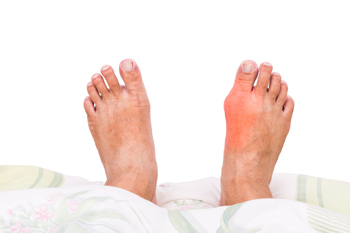 The painful condition that is known as gout is a form of arthritis. The pain is a result of excess uric acid that accumulates in the blood. This may cause crystals to form, which lodge in the joints of the big toe, and any inflammation that may occur will typically cause severe pain. This condition may develop if certain foods are ingested in excess on a frequent basis. These may include shellfish, red meat, or alcohol, and it is suggested to alter these choices for the possible prevention of gout. Research has shown there may be other factors why gout may develop, including genetic traits, ingesting specific medications, or enduring a recent trauma. If you feel you have gout, it is suggested to speak with a podiatrist as quickly as possible, so correct treatment options can be implemented.
The painful condition that is known as gout is a form of arthritis. The pain is a result of excess uric acid that accumulates in the blood. This may cause crystals to form, which lodge in the joints of the big toe, and any inflammation that may occur will typically cause severe pain. This condition may develop if certain foods are ingested in excess on a frequent basis. These may include shellfish, red meat, or alcohol, and it is suggested to alter these choices for the possible prevention of gout. Research has shown there may be other factors why gout may develop, including genetic traits, ingesting specific medications, or enduring a recent trauma. If you feel you have gout, it is suggested to speak with a podiatrist as quickly as possible, so correct treatment options can be implemented.
Gout is a foot condition that requires certain treatment and care. If you are seeking treatment, contact one of our podiatrists from Apple Podiatry Group. Our doctors will treat your foot and ankle needs.
What Is Gout?
Gout is a type of arthritis caused by a buildup of uric acid in the bloodstream. It often develops in the foot, especially the big toe area, although it can manifest in other parts of the body as well. Gout can make walking and standing very painful and is especially common in diabetics and the obese.
People typically get gout because of a poor diet. Genetic predisposition is also a factor. The children of parents who have had gout frequently have a chance of developing it themselves.
Gout can easily be identified by redness and inflammation of the big toe and the surrounding areas of the foot. Other symptoms include extreme fatigue, joint pain, and running high fevers. Sometimes corticosteroid drugs can be prescribed to treat gout, but the best way to combat this disease is to get more exercise and eat a better diet.
If you have any questions please feel free to contact our offices located in Arlington Fort Worth, And Flower Mound, TX . We offer the newest diagnostic and treatment technologies for all your foot and ankle needs.
Everything You Need to Know About Gout
Gout, typically found in diabetic patients, is an unusually painful form of arthritis caused by elevated levels of uric acid in the bloodstream. The condition typically strikes the big joint on the big toe. It has also been known to strike the knees, elbows, fingers, ankles and wrists—generally anywhere that has a functioning, moving joint.
The high level of uric acid in a person’s bloodstream creates the condition known as hyperuricema—the main cause of gout. Genetic predisposition occurs in nine out of ten sufferers. The children of parents who suffer gout will have a two in ten chance of developing the condition as well.
This form of arthritis, being particularly painful, is the leftover uric acid crystallizing in the blood stream. The crystallized uric acid then travels to the space between joints where they rub, causing friction when the patient moves. Symptoms include: pain, redness, swelling, and inflammation. Additional side effects may include fatigue and fever, although reports of these effects are very rare. Some patients have reported that pain may intensify when the temperature drops, such as when you sleep.
Most cases of gout are easily diagnosed by a podiatrist’s assessment of the various symptoms. Defined tests can also be performed. A blood test to detect elevated levels of uric acid is often used as well as an x-ray to diagnose visible and chronic gout.
Treatment for gout simply means eliminating symptoms. Non-steroid anti-inflammatory drugs or NSAIDs (Colchicine and other corticosteroid drugs, etc.) will quell the redness, the swelling, and the inflammation. However, managing your diet, lifestyle changes, and using preventative drugs are all helpful toward fully combating the most severe cases.
Those that lead an inactive lifestyle are at a higher risk for gout. Any amount of exercise decreases the probability of repeat encounters with the condition. Reducing your consumption of red meat, sea food, and fructose-sweetened drinks also reduces the likelihood of chronic gout as well.
Ingesting Vitamin C, coffee, and particular dairy products can help with maintaining a healthy lifestyle. There are new drugs out on the market that inhibit the body’s production of uric acid-producing enzymes. However, reducing or eliminating your overall levels of uric acid is the best remedy to ensuring you lead a gout-free life.
How Do Heel Spurs Form?
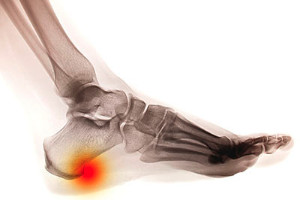 A heel spur occurs when a small and bony protrusion gradually forms on one of the 26 bones that are in the foot. This will typically occur in the heel of the foot and may produce severe pain and discomfort as a result of the inflammation that generally accompanies this condition. There may be several reasons why this ailment may occur, including wearing poorly fitted shoes, walking abnormalities in which excess pressure is placed on the heel, or additional weight the patient may have gained, which can put added strain on the heels. Depending on the severity of the heel spur, there may be different treatment options that may bring a moderate level of relief and comfort. Theses may include performing gentle stretches, which may benefit the overall health of the foot, wearing orthotics, or if necessary, surgery may be performed to remove the heel spur. If you have developed a heel spur, it is suggested to speak with a podiatrist who can determine what the best treatment is for you.
A heel spur occurs when a small and bony protrusion gradually forms on one of the 26 bones that are in the foot. This will typically occur in the heel of the foot and may produce severe pain and discomfort as a result of the inflammation that generally accompanies this condition. There may be several reasons why this ailment may occur, including wearing poorly fitted shoes, walking abnormalities in which excess pressure is placed on the heel, or additional weight the patient may have gained, which can put added strain on the heels. Depending on the severity of the heel spur, there may be different treatment options that may bring a moderate level of relief and comfort. Theses may include performing gentle stretches, which may benefit the overall health of the foot, wearing orthotics, or if necessary, surgery may be performed to remove the heel spur. If you have developed a heel spur, it is suggested to speak with a podiatrist who can determine what the best treatment is for you.
Heel spurs can be incredibly painful and sometimes may make you unable to participate in physical activities. To get medical care for your heel spurs, contact one of our podiatrists from Apple Podiatry Group. Our doctors will do everything possible to treat your condition.
Heels Spurs
Heel spurs are formed by calcium deposits on the back of the foot where the heel is. This can also be caused by small fragments of bone breaking off one section of the foot, attaching onto the back of the foot. Heel spurs can also be bone growth on the back of the foot and may grow in the direction of the arch of the foot.
Older individuals usually suffer from heel spurs and pain sometimes intensifies with age. One of the main condition's spurs are related to is plantar fasciitis.
Pain
The pain associated with spurs is often because of weight placed on the feet. When someone is walking, their entire weight is concentrated on the feet. Bone spurs then have the tendency to affect other bones and tissues around the foot. As the pain continues, the feet will become tender and sensitive over time.
Treatments
There are many ways to treat heel spurs. If one is suffering from heel spurs in conjunction with pain, there are several methods for healing. Medication, surgery, and herbal care are some options.
If you have any questions feel free to contact our offices located in Arlington Fort Worth, And Flower Mound, TX . We offer the latest in diagnostic and treatment technology to meet your needs.
How to Treat Heel Spurs
Heel spurs are calcium deposits that cause bone protrusions on the heel bone. Heel spurs are usually associated with plantar fasciitis, which occurs when the plantar fasciitis in the foot becomes inflamed. Typically, heel spurs don’t cause any symptoms. However, they can produce chronic or intermittent heel pain. Those who have had the condition often describe the irritation as a stabbing pain.
There are risk factors that may make you more likely to develop heel spurs. People who have abnormal walking gaits, run and jog on hard surfaces, are obese, or wear poorly fitting shoes are more likely to develop heel spurs.
Fortunately, there are precautions you can take to avoid developing heel spurs. One of the best ways to do this is by wearing well-fitting shoes with shock-absorbent soles. Another preventative technique is to choose running shoes if you plan on running, and walking shoes if you plan on walking. Shoes are made for different activities and it is important to research a shoe before you purchase a pair.
The pain associated with heel spurs often decreases the more you walk. However, a recurrence of pain after an extended period of rest or walking is likely to occur with this condition. Those with severe heel spur pain may opt to go the surgical route for treatment. However, more than 90% of those with the condition get better without surgical treatment. If you have a heel spur and want to know if surgery is right for you, you should go to your podiatrist and he or she will be able to conduct a pre-surgical test or exam to determine if you are an optimal candidate for surgery.
Warming Up the Muscles Before Running
 Research has shown the injuries that many runners experience can originate from training incorrectly or from following training techniques that are not conducive for properly warming up the muscles. The feet may endure added stress when running is performed for extended periods of time, and it is essential to practice an optimum stretching routine before embarking on this specific sport or hobby. There may be several factors that can determine the occurrence of running injuries, including the number of miles that are run per week, if a previous injury has happened, or if you are new to the sport of running. Injuries may be avoided by increasing the mileage and speed gradually, warming up the muscles correctly, and decreasing the intensity of the run a few days per week. If you would like additional information about how to prevent uncomfortable running injuries, please consult with a podiatrist.
Research has shown the injuries that many runners experience can originate from training incorrectly or from following training techniques that are not conducive for properly warming up the muscles. The feet may endure added stress when running is performed for extended periods of time, and it is essential to practice an optimum stretching routine before embarking on this specific sport or hobby. There may be several factors that can determine the occurrence of running injuries, including the number of miles that are run per week, if a previous injury has happened, or if you are new to the sport of running. Injuries may be avoided by increasing the mileage and speed gradually, warming up the muscles correctly, and decreasing the intensity of the run a few days per week. If you would like additional information about how to prevent uncomfortable running injuries, please consult with a podiatrist.
Exercising your feet regularly with the proper foot wear is a great way to prevent injuries. If you have any concerns about your feet, contact one of our podiatrists of Apple Podiatry Group. Our doctors will treat your foot and ankle needs.
How to Prevent Running Injuries
Many common running injuries are caused by overuse and overtraining. When the back of the kneecap starts wearing out and starts causing pain in your knee, this is commonly referred to as runner’s knee. Runner’s knee is a decrease in strength in your quadriceps and can occur if you’re not wearing properly fitted or supporting shoes. To prevent runner’s knee, focusing on hip strengthening is a good idea, as well as strengthening your quads to keep the kneecaps aligned.
What Are Some Causes of Running Injuries?
- One cause of a common running injury is called iliotibial band syndrome.
- Plantar fasciitis is also another common injury.
- Stress fractures can occur from overtraining, lack of calcium, or even your running style.
Best Ways to Prevent Running Injuries
- Wear footwear that fits properly and suits your running needs.
- Running shoes are the only protective gear that runners have to safeguard them from injury.
- Make a training schedule. Adding strengthening exercises as well as regular stretching can help keep you strong and limber and can lessen the possibility of injuries.
- Stretching keeps muscles limber; this will help you gain better flexibility.
If you have any questions please feel free to contact our offices located in Arlington Fort Worth, And Flower Mound, TX . We offer the newest diagnostic and treatment technologies for all your foot and ankle needs.
